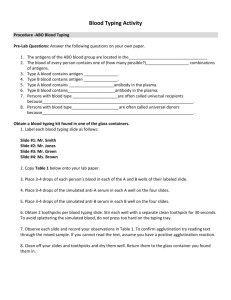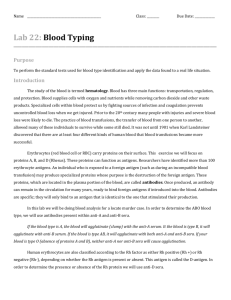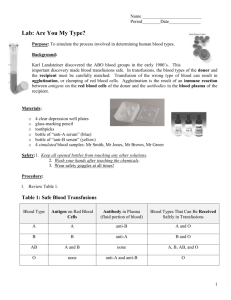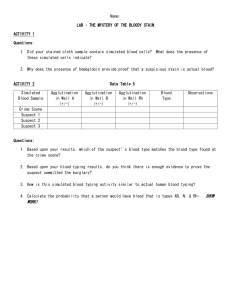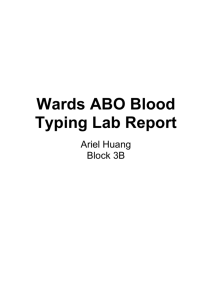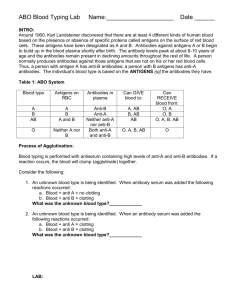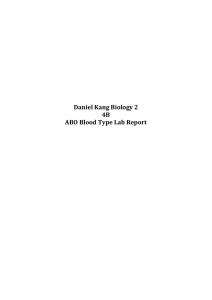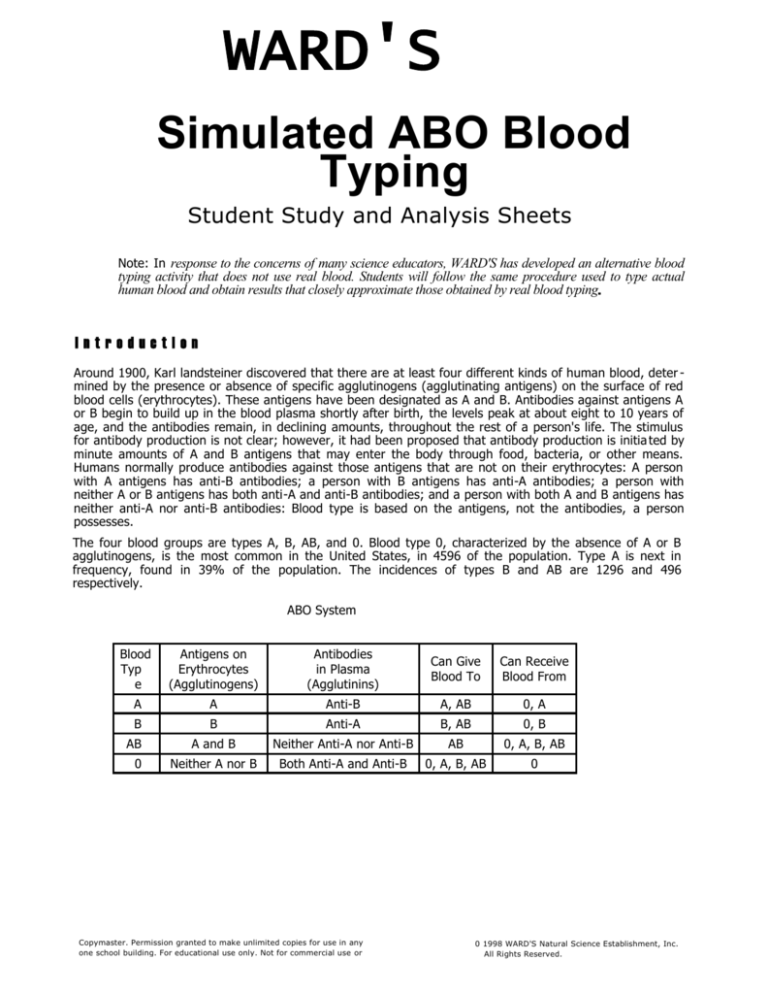
WARD'S
Simulated ABO Blood
Typing
Student Study and Analysis Sheets
Note: In response to the concerns of many science educators, WARD'S has developed an alternative blood
typing activity that does not use real blood. Students will follow the same procedure used to type actual
human blood and obtain results that closely approximate those obtained by real blood typing.
Introduction
Around 1900, Karl landsteiner discovered that there are at least four different kinds of human blood, deter mined by the presence or absence of specific agglutinogens (agglutinating antigens) on the surface of red
blood cells (erythrocytes). These antigens have been designated as A and B. Antibodies against antigens A
or B begin to build up in the blood plasma shortly after birth, the levels peak at about eight to 10 years of
age, and the antibodies remain, in declining amounts, throughout the rest of a person's life. The stimulus
for antibody production is not clear; however, it had been proposed that antibody production is initia ted by
minute amounts of A and B antigens that may enter the body through food, bacteria, or other means.
Humans normally produce antibodies against those antigens that are not on their erythrocytes: A person
with A antigens has anti-B antibodies; a person with B antigens has anti-A antibodies; a person with
neither A or B antigens has both anti-A and anti-B antibodies; and a person with both A and B antigens has
neither anti-A nor anti-B antibodies: Blood type is based on the antigens, not the antibodies, a person
possesses.
The four blood groups are types A, B, AB, and 0. Blood type 0, characterized by the absence of A or B
agglutinogens, is the most common in the United States, in 4596 of the population. Type A is next in
frequency, found in 39% of the population. The incidences of types B and AB are 1296 and 496
respectively.
ABO System
Blood
Typ
e
Antigens on
Erythrocytes
(Agglutinogens)
Antibodies
in Plasma
(Agglutinins)
Can Give
Blood To
Can Receive
Blood From
A
A
Anti-B
A, AB
0, A
B
B
Anti-A
B, AB
0, B
A and B
Neither Anti-A nor Anti-B
AB
0, A, B, AB
Neither A nor B
Both Anti-A and Anti-B
0, A, B, AB
0
AB
0
Copymaster. Permission granted to make unlimited copies for use in any
one school building. For educational use only. Not for commercial use or
resale.
0 1998 WARD'S Natural Science Establishment, Inc.
All Rights Reserved.
Process of Agglutination
There is a simple test to determine blood type, performed with antisera containing high levels of anti -A and
anti-B agglutinins. Several drops of each kind of antiserum are added to separate samples of blood. If agglutination (clumping) occurs only in the suspension to which the anti-A serum was added, the blood type is A. If
agglutination occurs only in the anti-B mixture, the blood type is B. Agglutination in both samples indicates that
the blood type is AB. The absence of agglutination in any sample indicates that the blood type is O.
Agglutination Reaction of ABO Blood-Typing Sera
Reaction
Anti-A Serum
Anti-B Serum
Blood Type
Agglutination
No Agglutination
Type A
No Agglutination
Agglutination
Type B
Agglutination
Agglutination
Type AB
No Agglutination
No Agglutination
Type O
Importance of Blood Typing
As noted in the table above, people can receive transfusions of only certain blood type s, depending on the
type of blood they have. If incompatible blood types are mixed, erythrocyte destruction, agglutination and
other problems can occur. For instance, if a person with Type B blood is transfused with blood type A, the
recipient's anti-A antibodies will attack the incoming type A erythrocytes. The type A erythrocytes will be
agglutinated, and hemoglobin will be released into the plasma. In addition, incoming anti -B antibodies of the
type A blood may also attack the type B erythrocytes of the recipient, with similar results. This problem may
not be serious, unless a large amount of blood is transfused.
The ABO blood groups and other inherited antigen characteristics of red blood cells are often used in
medicolegal situations involving identification of disputed paternity. A comparison of the blood groups of
mother, child, and alleged father may exclude the man as a possible parent. Blood typing does not prove
that an individual is the father of a child; it merely indicates whether or not he is a possible parent. For
example, a child with a blood type of AB, whose mother is type A, could not have as a father a man whose
blood type is O.
The Genetics of Blood Types
The human blood types (A, B, AB, and O) are inherited by multiple alleles-three or more genes that occupy
a single locus on a chromosome. Gene I^ codes for the synthesis of antigen (agglutinogen) A, gene III codes
for the production of antigen B on the red blood cells, and gene i (i o) does not produce any antigens. The
phenotypes listed in the table below are produced by the combinations of the three different alleles: I^, III,
iO. When genes III and I^ are present in an individual, both are fully expressed. Both IA and III are dominant
over io; the genotype of an individual with blood type O must be ioio.
Phenotypes
Possible Genotypes
A
I AI A
IAI (or lo)
B
IBIB
IBI (lo)
O
ii (lolo)
Use IA for antigen A, III for antigen B, i or lo for no antigens
present Genes I^ and I B are dominant over i (lo)
AB blood type results when both genes I^ and IB are present
Artificial Blood
At times it is difficult to find a correct match for a blood type of a person requiring a transfusion. It would
be ideal to have some type of artificial blood or blood substitute that wouldn't need to be matched to a
patient's blood type; it could save thousands of lives each year. Although the research for artificial blood
and blood substitutes continues, it may take years before one is available.
Copymaster. Permission granted to make unlimited copies for use in
any one school building. For educational use only. Not for commercial
use or resale.
O 1998 WARD'S Natural Science Establishment Inc. All
Rights Reserved.
3
In 1966, Dr. Leland C. Clark, of the University of Cincinnati's College of Medicine, developed the first artificial
blood prototype. This milky white solution, which can carry twice as much oxygen as blood does, is a fluorocarbon emulsion called Fluosol. It is made up of two fluorocarbons, a number of salts, water, and fine particles
that are 1/70 the size of erythrocytes. Because these particles are so small, they can pass through narrowed
arteries that the larger erythrocytes can't get through, making it an ideal blood substitute for heart attack and
stroke victims; they would recover faster and have less tissue damage. Fluosol has been approved for use in
Canada, Holland, and Italy. The US Food and Drug Administration is reviewing Fluosol for use in the United
States.
Anthony Hunt and colleagues at the University of California at San Francisco are working with artificial red
blood cells called neohemocytes. Neohemocytes, which are microscopic spheres of hemoglobin surrounded by
lipids, are capable of carrying oxygen. These microspheres are proving to be a successful substitute for erythrocytes. As with Fluosol, their small size allows them to pass through restricted vessels that might not allow
the passage of erythrocytes.
Objective
To use WARD'S Simulated Blood to determine the blood type of four individuals. Also to use a simplified
counting technique to estimate the number of red and white blood cells per cubic millimeter.
A. ABO Blood Typing
Materials Needed per Lab Group
4 Blood Typing Slides
8 Toothpicks
Shared Materials
4 Unknown Blood Samples
Mr. Smith
Mr. Jones
Mr. Green
Ms. Brown
Simulated Anti-A Typing Serum
Simulated Anti-B Typing Serum
Procedure
1. Label each blood typing slide:
Slide
Slide
Slide
Slide
#1: Mr. Smith
#2: Mr. Jones
#3: Mr. Green
#4: Ms. Brown
2. Place three to four drops of Mr. Smith's blood in each of the A and B wells of Slide #1.
3. Place three to four drops of Mr. Jones's blood in each of the A and B wells of Slide #2.
4. Place three to four drops of Mr. Green's blood in each of the A and B wells of Slide #3.
5. Place three to four drops of Ms. Brown's blood in each of the A and B wells of Slide #4.
6. Add three to four drops of the simulated anti-A serum in each A well on the four slides.
7. Add three to four drops of the simulated anti-B serum in each B well on the four slides.
8. Stir each mixture with a different clean toothpick. Use only one toothpick per well to avoid cross
contamination.
9. Examine each well for agglutination. Agglutination indicates a positive test result. Record results in Table 1.
Copymaster. Permission granted to make unlimited copies for use
in any one school building. For educational use only. Not for
commercial use or resale.
O 1998 WARD'S Natural Science Establishment, Inc.
Ail Rights Reserved.
Analysis
Table 1 Agglutination
Reactions
Anti-A Serum
Anti-B Serum
Blood Type
Slide #1: Mr. Smith
Slide #2: Mr. Jones
Slide #3: Mr. Green
Slide #4: Ms. Brown
B. (Optional) Blood Cell Count
Note: WARD'S Simulated Blood contains components that simulate red and white blood cells; they
are similar in proportion and size to those found in real human blood and can be seen under the
microscope without staining.
Materials Needed per Lab Group
1 Microscope Slide
1 Coverslip
WARD'S Simulated Blood
Compound Microscope (400X magnification)
Procedure
1. Thoroughly shake one of the vials of WARD'S Simulated Blood. Add a small drop of simulated blood to a
microscope slide. Cover with a coverslip.
Note: Lower the coverslip slowly to avoid trapping air bubbles on the slide.
2. Use a paper towel to absorb any excess sample from the edge of the coverslip.
3. Examine the slide with the low power objective. Find the area of the slide with the best distribution of
cells-one that has a minimum of 20 red blood cells.
4. Switch to 400X magnification and count the number of simulated red blood cells. Re cord the number in
Table 2.
Note: Like real blood cells stored at room temperature for long periods of time, some cells
will clump together. Count the cells in any clump separately.
5. Count the number of simulated white blood cells. Record the number in Table 2.
6. Repeat the counting procedure with two other fields of view. Record these counts in Table 2.
Copymaster. Permission granted to make unlimited copies for use in
any one school building. For educational use only. Not for commercial
use or resale.
O 1998 WARD'S Natural Science Establishment Inc. All
Rights Reserved.
Analysis
1. Calculate the average of the three cell counts.
2. Multiply the average number of cells by the dilution factor to determine the number of red and white
blood cells per cubic millimeter.
Note: The average count is multiplied by the factor indicated in the table for simulated red
and white blood cells to correct for dilution and for the fact that only a small volume of blood
was observed. The method used is not the actual blood cell counting procedure. A
hemacytometer may be used to demonstrate to students the actual counting technique used
in clinical settings.
Cell Count
Blood
Cell Type
1
2
Table 2
3
Avg. No.
of Cells
Red (Red)
White (Blue)
Dilution
Factor
Total No.
Blood Cells per mm 3
(Avg. No. of Cells x Dilution Factor)
150,000
5,000
Questions
ABO Blood Group
1. What is Mr. Smith's blood type? What ABO agglutinogens are present in his red blood cells?
2. What is Mr. Green's blood type? What ABO agglutinins are present in the plasma of his blood?
3. What is Mr. Jones's blood type? If Mr. Jones needed a transfusion, what blood type(s) could he safely
receive?
Copymaster. Permission granted to make unlimited copies for use in any
one school building. For educational use only. Not for commercial use or
resale.
O 1998 WARD'S Natural Science Establishment, Inc. All
Rights Reserved.
4. What is Ms. Brown's blood type? What blood type(s) could safely receive her donated blood?
5. Why is it necessary to match the donor's and recipient's blood before a transfusion?
6. What happens to red blood cells that are agglutinated?
7. What is the difference between agglutinogens and agglutinins?
8. How are ABO blood types determined?
Copymaster. Permission granted to make unlimited copies for use in
any one school building. For educational use only. Not for commercial
use or resale.
O 1998 WARD'S Natural Science Establishment, Inc. All
Rights Reserved.
9. Could a man with an AB blood type be the father of a child with type O blood?
10. Could a man with an O blood type be the father of a child with type AB blood?
11. Could a type B child with a type A mother have a type A father?
12. What are the possible genetic combinations of a child whose parents' blood types are A and B?
Copymaster. Permission granted to make unlimited copies for use in
any one school building. For educational use only. Not for commercial
use or resale
O 1998 WARD'S Natural Science Establishment, Inc. All
Rights Reserved.
Science in Motion
Materials List
Lab: Simulated ABO Blood Typing
Number of Lab Groups Prepared:__________
Equipment per lab group
4 Blood Typing Slides
Compound Microscope (400x
magnification)
Consumables
8 Toothpicks
Simulated Blood
Serum for Blood type A (1 bottle)
Serum for Blood type B (1 bottle)
.
Serum for RH factor (1 bottle)
Delivered
Delivered
Returned

